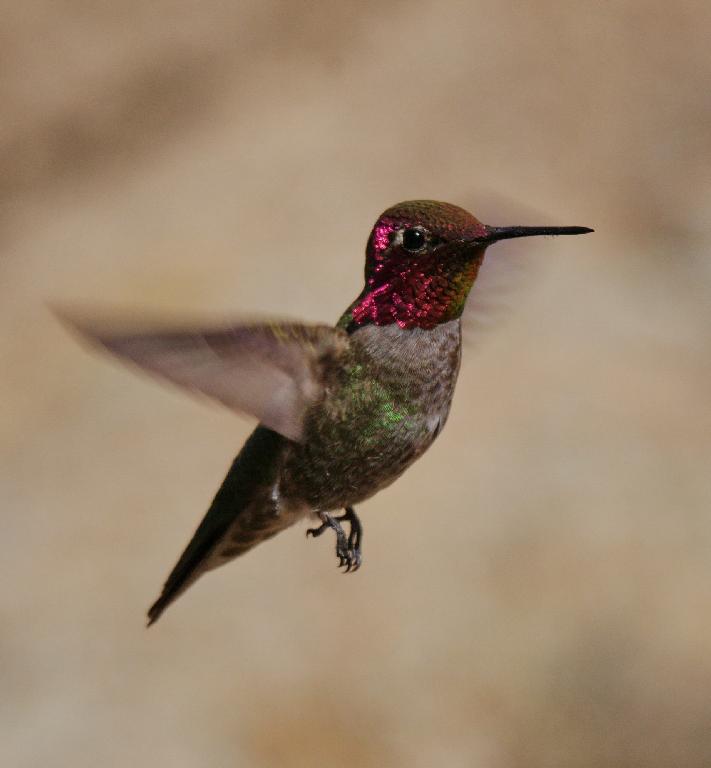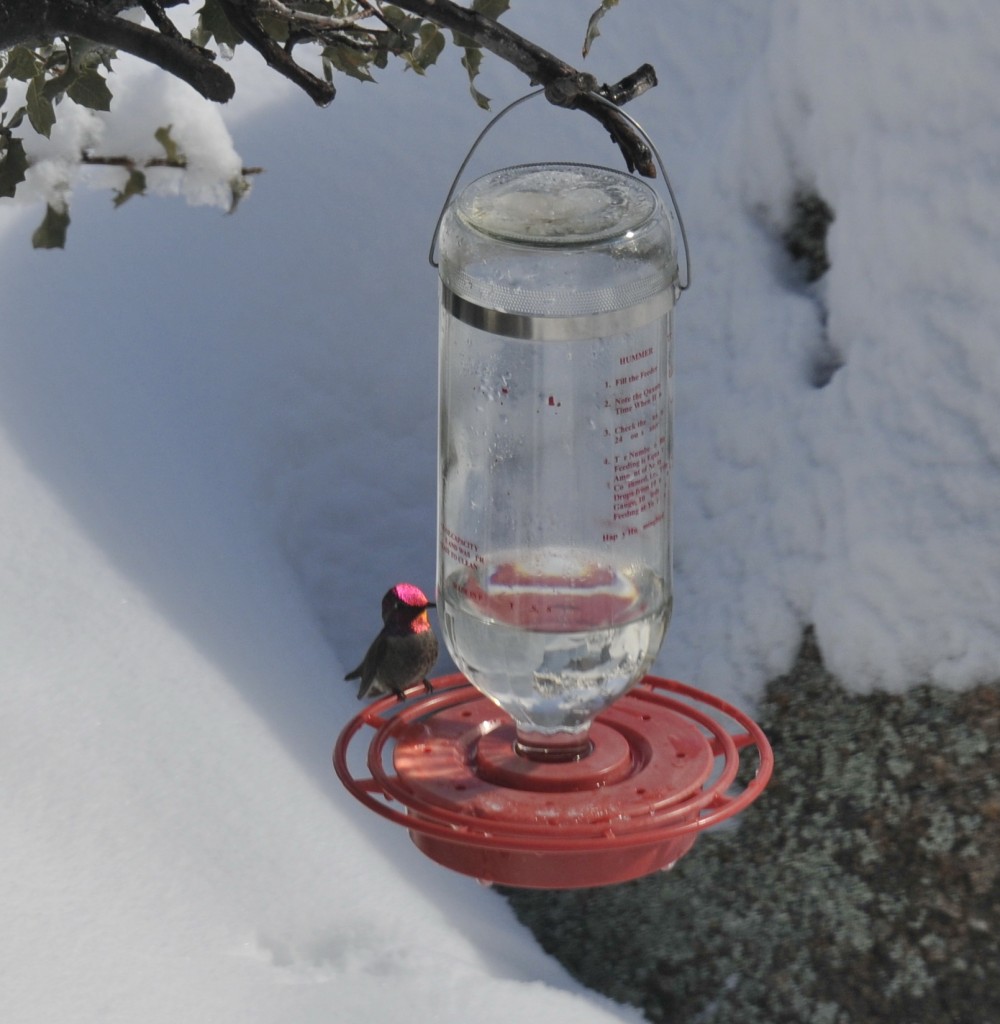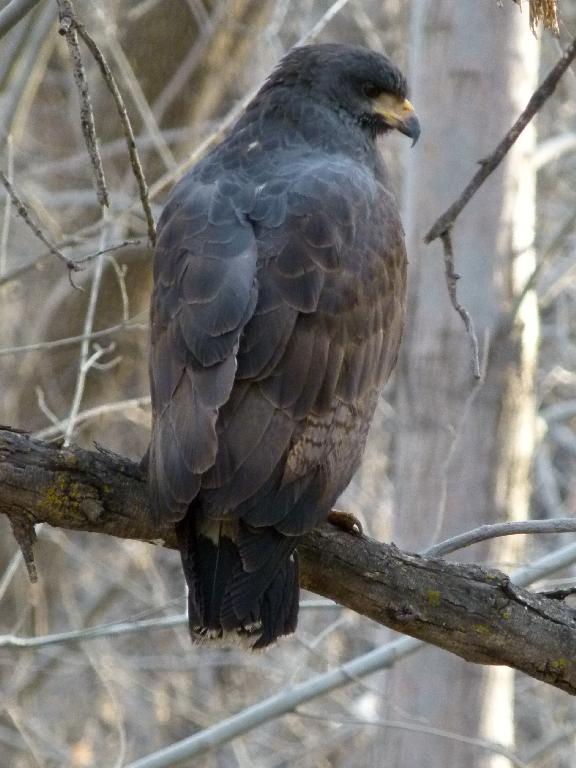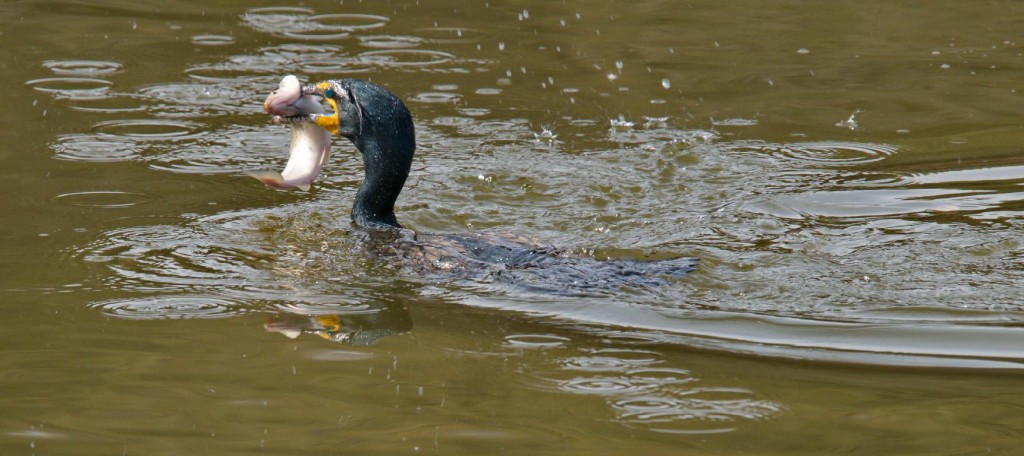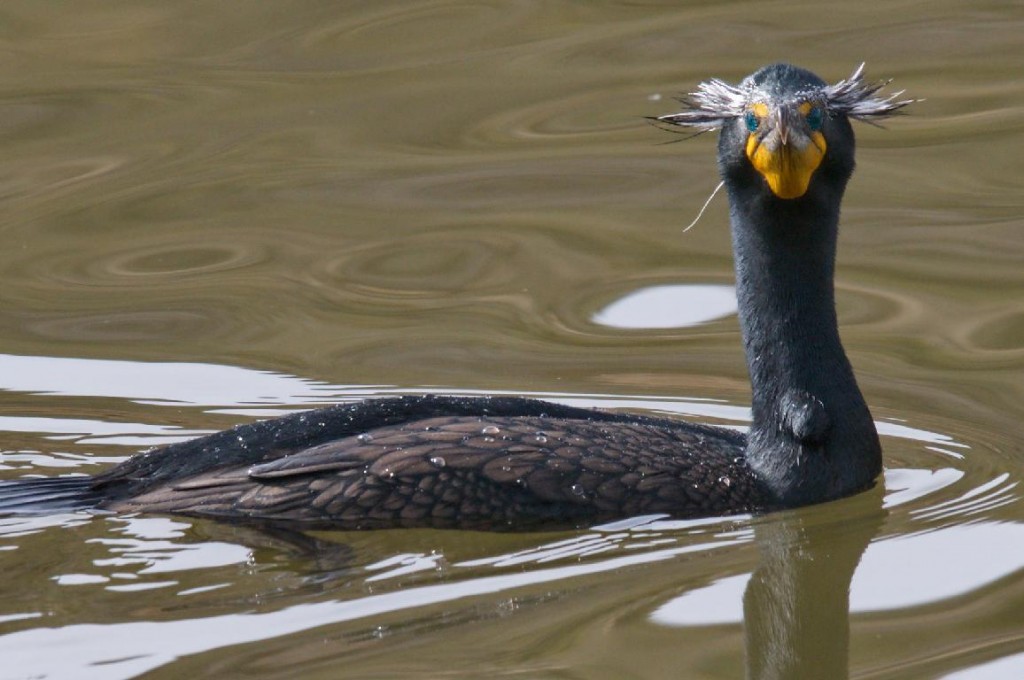No, I am not going to pontificate on the NCAA basketball tournament in progress, though the testosterone-driven excitement around the games certainly parallels the changes that I see in the hummingbirds in my yard. Anna’s Hummingbirds have been chasing each other around like ballistic missiles with hyperdrive all month. When a surprising snowstorm raged through Arizona in the final two days before the vernal equinox, it was shocking to see zipping flashes of hot pink though the snowflakes. When I would replace a feeder of frozen nectar with fresh liquid, the feisty little birds buzzed my head as if annoyed that I was not out there at the crack of dawn with sugary elixir. Patience is not a hummingbird virtue.
Wind rattles the windows this 25th day of March as a front bustles through with aeolian impatience. In western Oregon, there would be rain by now; here, the chance is a mere 20 percent. But the wind has just delivered some competition for my aggressive little Anna’s. The first Broad-tailed and Black-chinned Hummingbirds showed up within ten minutes of each other. Three species of hot-blooded intensity all going for the same rewards. Bound to be trouble, and there is. Not to mention that a couple Acorn Woodpeckers decided to sit on the hummingbird feeders this morning to probe for nectar, something the Ladder-backed Woodpeckers and House Finches have been trying, as well. Perhaps the woodpeckers were displaced from the suet feeders by the dominant flickers. I wouldn’t mess with a bird with a beak like that either! In any case, there is a multi-species feeding frenzy going on, and I am lucky to be witnessing it.
Change is in the air. I am teaching a class in ecology this spring, the perfect time to see ecology in action. Never content with assumptions about what might be out there, I prefer to scout for field trips when I can. The land is dynamic, and advance preparation helps me respond to the vagaries of timing—what plants are now blooming, what unexpected food source has drawn in visitors, and the like. Scouting is my favorite form of procrastination. I like to think that the genetic legacy of my hunter-gatherer ancestors outweighs any inherent proclivity to hammer on a keyboard.
Last evening I was returning from scouting at Walnut Creek up in the Juniper Mountains north of Prescott. A late-day shaft of light struck the pinnacles of Granite Dells ahead, and I was struck with a feeling of intense happiness to live in such an awe-inspiring landscape. Crossing the Granite Creek bridge while in a sort of mental reverie, I barely noticed the small flock of Wood Ducks on the stream to my right. Wait! There was something else. Suddenly, but not abruptly, I hit the brakes after crossing the bridge. A dark shape had registered in my distracted mind as I glimpsed the Wood Ducks. Instinctively I knew what the dark blob was—and I prayed I could back up carefully enough to keep from flushing it. To my relief, it was still there—a Common Black-Hawk—perched on a slanting bridge above the stream, apparently not worried at all by the vehicle rumbling softly no more than twenty feet away.
Like the arriving hummingbirds, this hawk knows that spring is advancing, that despite the blizzard of a week ago, winter has lost its grip. The days are lengthening, the frosts are becoming fewer. The cottonwoods (if they were conscious) might be regretting having been in full flower when the heavy snows hit, but their boughs have sprung back from the niveal burden. The robins and bluebirds that gathered at the roadsides for the worms exposed by snowmelt there have dispersed again as the snow quickly melted to feed the fresh currents of runoff gathered by the embracing waters of the creeks, which had been stagnant for months.
Spring storms often coincide with arrival of migrants. March 7 was stormy, and in the gusts, the year’s first Zone-tailed Hawk struggled into the wind over me. The species nests nearby, but I don’t know if this is a local bird or one moving on through. Now the black-hawk is here, watching for crayfish or frogs or whatever else it can find along the creek. Its presence had no effect on the Wood Ducks; not all predators pose a risk. I wonder if the local Yellow-billed Cuckoos, currently down in the tropics being tropical, are making plans to wing it up here in time for caterpillar emergence in the steamy monsoons.
These days the White-crowned Sparrows sing with growing fervor, their bodies ramping up for the breeding season ahead. They are not on territory here; they forage peacefully together for bird seed on the ground. Perhaps they are practicing; maybe the vocal virtuosos winning the winter talent contest will be victorious in the mating game when they arrive in their summer haunts. Zugenruhe—migratory restlessness—is preparing them for their journeys.
I am restless too, though I am not sure if my uneasiness is similar to that of these sparrows or the Rock Squirrels now active after zoning out most of the winter in their subterranean chambers. The squirrels are experiencing “recrudescence of the gonads”—how I love the way scientists talk sex!
March madness has been known in England since well before basketball was invented. There it was associated with the vernal nuptials of hares. Lengthening days stimulate the pituitary, so I’m told, and hormones begin to surge, driving the crazy antics of leaping, boxing, and similar hare-brained behaviors. You have to realize, of course, that it’s not the rational brain that drives the courtship, it’s all about sex.
Changes are happening at Watson and Willow Lakes, too. The graceful swans are gone, along with many of the ducks that wintered here (Northern Shovelers, still reveling in the abundance of plankton, are a notable exception). Cormorants and herons have set up their breeding colony on the Cottonwood Peninsula at Willow Lake. Those cormorants nesting in the old snag are not doing as well as those that moved to the living trees nearby, as the snag has little left for nest attachment, but some habits are hard to break.
Cormorant numbers have been increasing in recent years—not just the usual suspects, the Double-crested, but also the Neotropical. When I was in grad school at the U of A in the early 1970s, the only place you had a good chance of seeing a Neotropical (then called Olivaceous) was at the San Bernardino Ranch in the far southeast corner of the state. Now they are regular breeders in Phoenix and possibly breed here in Prescott. Please don’t inform Sheriff Joe Arpaio about the northward spread of these dark-skinned immigrants.
Earlier this month, Arizona Game & Fish released catchable trout in Fain Park on Lynx Creek. The press release must have had wide distribution, for when human fishermen lined up on shore, herons and cormorants (both species) also arrived in numbers. The humans were clearly outclassed, watching in frustration as fat trout struggled within the gapes of satisfied birds.
Clearly the birds are opportunistic, but how do they discover these opportunities? Just how does the word (no doubt a poor choice of words on my part) spread so that Fain Park, a tiny dot on the map, becomes a beacon for hungry fish-eating birds? I found out through an email rare bird alert. What is the avian equivalent?
“There is nothing new under the sun” certainly doesn’t apply in ecology. To the observant, each day brings something new, something to challenge our preconceptions. There are patterns, for sure, but the exceptions keep us guessing, keep us looking. There are discoveries to make, even if they are no more than personal revelations. The keys are to be open to them, to recognize them, to embrace and cherish them. From simple pleasures comes profound and deep satisfaction.

